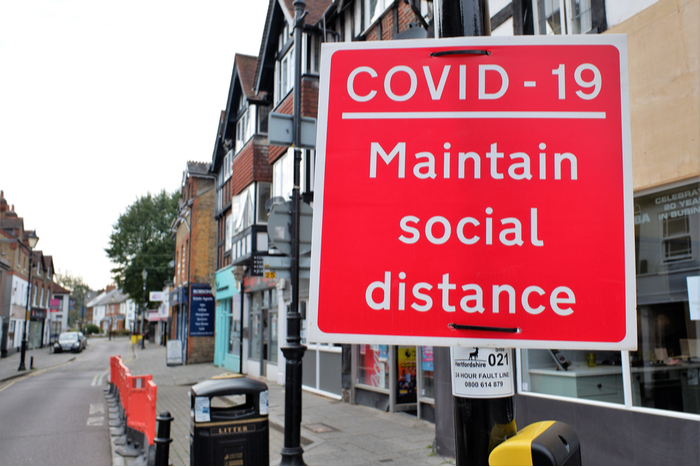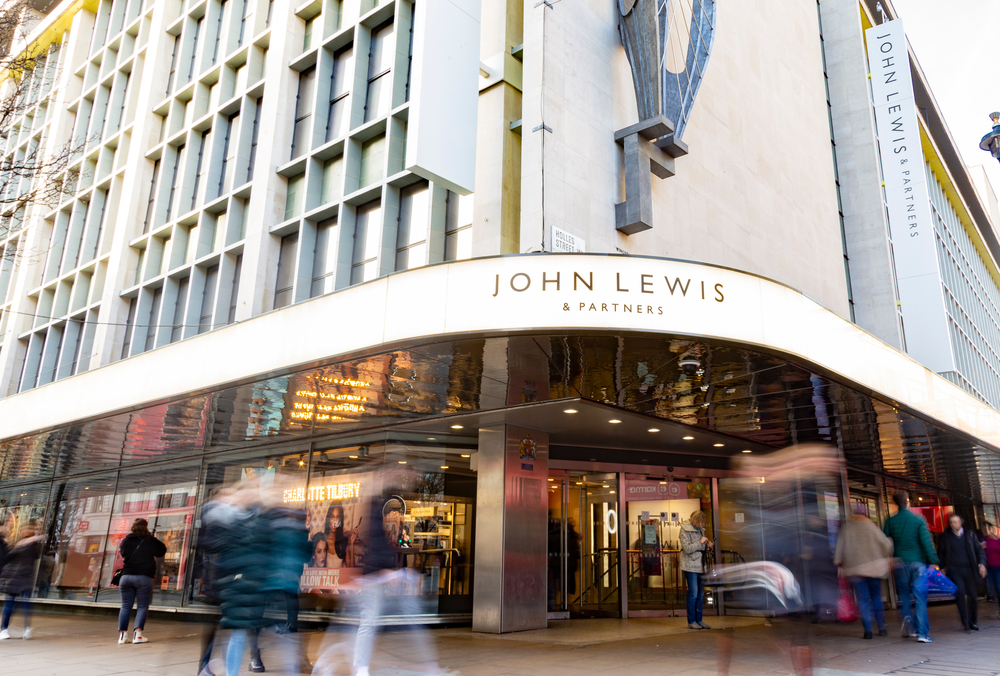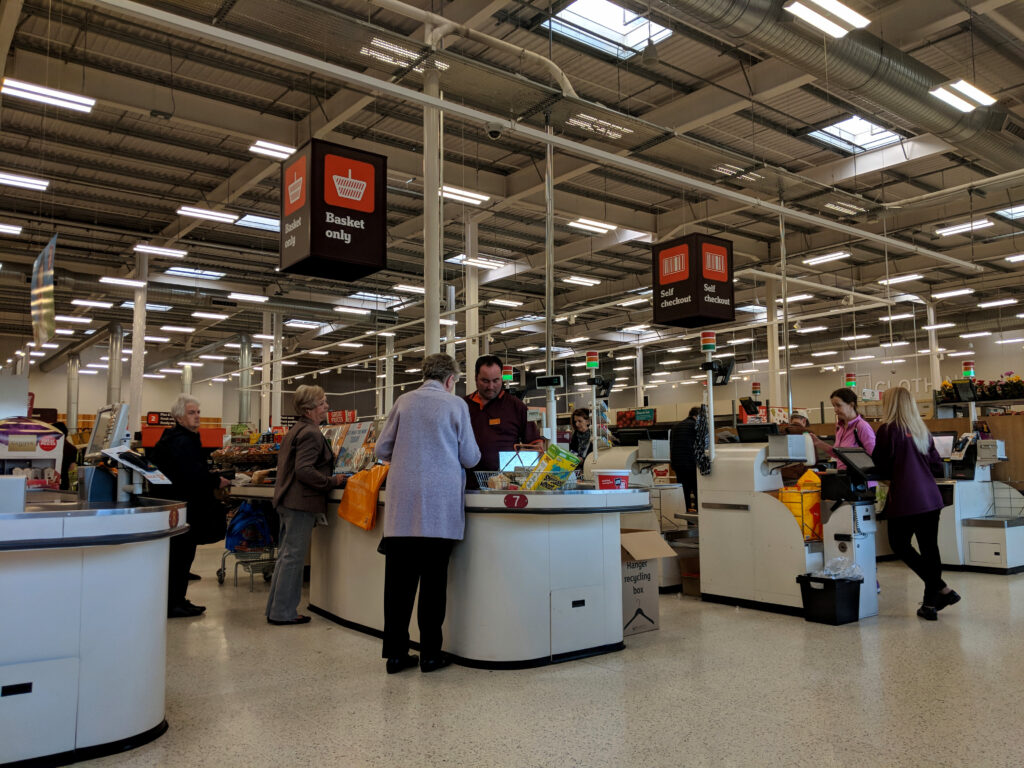March 23 marks one year since Prime Minister Boris Johnson declared the first UK-wide lockdown and stay-at-home order to control the rapid spread of Covid-19.
It ushered in some of the most drastic restrictions on everyday life since World War II, and saw a massive shift in consumer habits in retail. What was meant to be three weeks turned into three months, followed by brief reopenings and series of restrictions, and two additional lockdowns.
As non-essential retailers and other high street services and businesses were ordered to close during each of the lockdowns, essential retailers such as grocers witnessed a huge rise in demand as they were allowed to keep their shops open. In fact, in the early months of the pandemic demand was so high that grocers had to introduce rationing rules on essential items such as flour, toilet rolls, baked beans and pasta due to customers stockpiling out of fear.
Yet while essential retailers enjoyed a boom, it was still doom and gloom for UK retail as a whole. According to the ONS, total UK retail sales volumes in 2020 fell by 1.9 per cent compared with 2019, marking the largest annual fall on record.

England went into its latest lockdown on January 5, shortly after London and and the South East were placed under a localised lockdown before Christmas. Scotland also entered its current national lockdown on January 5. For Wales it started on December 19 and Northern Ireland on December 26.
As with previous lockdowns, only essential retailers were allowed to keep their stores open for trade. Although the definition of “essential retail” varied in each home country, at the very least this meant grocers and convivence stores. Some countries like Scotland and Northern Ireland went further to ban non-essential click-and-collect services.
BRC chief executive Helen Dickinson labelled 2020 as the “worst year on record” for retail sales growth, as physical non-food stores – including all of non-essential retail – saw sales drop by a quarter compared with 2019.
Meanwhile, Centre for Retail Research director Professor Joshua Bamfield said there were around 14,809 permanent retail store closures in the UK between March 2020 and February 2021. These were brought about by a wave of administrations, CVAs and restructures or rationalisations, and resulted in over 180,000 job losses.
These figures were also deeper than the 14,436 store closures and 127,884 job losses recorded in the prior year.
Meanwhile, according to research from PwC and the Local Data Company, 17,532 chain stores closed down over the last 12 months, while only 7655 opened up. This left a net deficit of 9877 permanent store closures – the highest on record – and equates to 48 stores closing every day, with just 21 opening.

As big names such as Marks & Spencer and John Lewis announced radical strategies to try and turn their businesses around – such as M&S launching third-party brands and John Lewis planning mini shops in Waitrose stores – other retailers such as Debenhams, Oasis and Warehouse, and Sir Philip Green’s Arcadia Group retail empire have all disappeared from the high street altogether.
However, their demise cannot be blamed solely on the pandemic as these retailers had all been struggling for some time. Covid-19 simply exacerbated their issues and delivered the final nail in the coffin.
Other retailers have also announced plans to shut stores as Covid-19 continues to present challenges. For example, H&M is set close 250 stores globally this year, Thorntons is shutting down all of its standalone shops to focus on its ecommerce operations, while John Lewis, which shut eight stores last year, expects more store closures in the coming months.
And for retailers without a strong ecommerce channel, their businesses were at risk as consumers’ shift to online shopping experienced a dramatic acceleration when lockdown came into effect in the UK a year ago.
Furthermore, stay-at-home orders coupled with travel restrictions has led to retailers with a significant number of stores in travel terminals – such as WHSmith, Paperchase and Oliver Bonas – to depend on their online channels.

According to the ONS, overseas residents made 398,000 visits to the UK from April to June 2020, marking a 96 per cent drop compared to the same period the year prior. Overseas residents also spent £218 million on their visits to the UK during the same period, which was 97 per cent less than 2019.
With the UK’s first Covid-19 case discovered on January 29 last year in York, England, the case numbers shot up in a matter of weeks and prompted the UK’s risk level to rise from low to moderate. Numbers were rising dramatically in other countries around the world as well, and hotspots such as China and Italy were already under lockdown. On March 11, the World Health Organisation declared Covid-19 a pandemic, and more and more countries went into lockdown.
On December 8, 90-year-old Margaret Keenan became the first person to receive the Pfizer vaccine in the UK. The news ushered in a new wave of hope for Brits, and with over 41 per cent of the country’s population now being given the first of the two required vaccinations, indicative dates of when non-essential retail can reopen (again) have been announced.
For England – home to 84 per cent of the UK’s population and the majority of retail destinations – the end of lockdown for non-essential retail has been set for no earlier than April 12.
In Wales, non-essential retail started to reopen earlier this week. However, the Welsh Government’s reopening approach is cautious and gradual, and most non-essential retailers will remain shut and will reopen on April 12 – the same as England.
Meanwhile in Scotland, some non-essential shops such as garden centres and homeware stores, plus non-essential click-and-collect services, can start to reopen open from April 5. But most non-essential retailers will remain closed until April 26.
As for Northern Ireland, from April 1 click-and-collect purchases will be allowed from garden centres and plant nurseries before being extended to all non-essential click-and-collect from April 12. Unlike the other UK nations, Northern Ireland said its lockdown exit would be driven by data, and as a result has not yet provided indicative dates of when non-essential shops can reopen.
Nonetheless, the Prime Minister previously expressed hopes that all Covid-19 restrictions across most facets of life could be lifted by late June.

“It has been an extremely challenging year for retail, and with several large retailers very sadly no longer in business, this is evidence of the extremely tough trading environment,” BRC business and regulation director Tom Ironside told Retail Gazette.
“Enforced closures during lockdowns have cost stores over £22 billion in lost sales, and footfall has remained significantly down throughout the past year.”
The restrictions of the last 12 months ushered in new in-store safety arrangements, such as Perspex screens and earlier opening hours for the elderly and NHS workers. Face coverings in England became mandatory for people visiting shops from July 24, Wales from June 9, Northern Ireland from August 10, and Scotland from October 30.
Meanwhile, a business rates holiday and furlough scheme were among support measures given by the UK Government to help retailers through the crisis. These have been largely extended into the new tax year by both Westminster and the devolved administrations of the home countries, and Chancellor Rishi Sunak’s Budget announcement in early March also had a raft of other support measures for businesses.
“It has been an extremely challenging year for retail”
One of the key elements of the Budget was how the business rates holiday would be extended until the end of June. For the remaining nine months of the tax year, business rates would be discounted by two-thirds. This only applies to England, and separate announcements of a full 12-month extension of the rate holiday were made in Wales and Scotland.
Sunak also confirmed the furlough scheme would be extended until the end of September, and employees would continue to receive 80 per cent of their salary for hours not worked.
The Budget also featured a “new restart grant” that would be provided in April to help businesses reopen as the phased lockdown exit plan ramps up from that month. This meant non-essential retailers could receive grants of up to £6000 per premises.
There were other elements to the Budget that pertained to the retail industry, such as a new Recovery Loan Scheme to replace previous Covid-19 loan packages, an increase in the national minimum wage £8.91 an hour, a new Help to Grow scheme that small retailers can apply for, and more than £1 billion for 45 new towns deals.
There is also an increase in the corporation tax from 19 per cent to 25 per cent in 2023. This would only affect retailers that have profits of £50,000 or more, and the tax rate would tapered from that level upwards. Sunak said only businesses with profits of £250,000 or greater would be taxed at the full 25 per cent rate.
“We were pleased to hear the Chancellor would be extending business rates reliefs for retail at 100 per cent for three months, then 66 per cent for the remaining nine months,” Federation of Small Businesses (FSB) national chair Mike Cherry said.
“We want to see the government’s support measures continually evolving, making sure small firms are not only able to survive but also grow.”
On the other hand, Dickinson said the government has an opportunity to put retail on a stronger course through its upcoming business rates review, by fixing the broken system. She said the current business rates regime was holding back investment in local shopping destinations and putting tens of thousands of retail jobs at risk.
“Enforced closures during lockdowns have cost stores over £22bn in lost sales”
The demise of some chains over the last 12 months mean some retailers may now be able to negotiate good rent deals for prime spots, as landlords look to avoid having empty shops in their portfolios.
A ban on business evictions was also introduced to help high street firms, and it has since been extended. While some retail tenants have agreed rent holidays and deferrals with landlords, building owners have said that some occupiers refusing to pay rent were big, profitable companies.
The British Property Federation estimated that total rent unpaid for UK commercial property between late March 2020 and the end of June 2021 would be up to £7 billion if the current rate of non-payment continues.
Retail expert Nelson Blackley said there was now a “new shopper loyalty factor” that emerged over the past year.
“The ‘infection protection perception’ can be defined as ‘the customer’s perceived safety from the risk of Covid-19 whilst visiting a specific store’,” he said.
“This is the single most important consideration many shoppers now take into account when choosing which retail outlet to visit.
“Retailers need to do everything possible to minimise the perceived risk of infection and so reduce emotional stress for their customers and of course their staff and the adverse impact that this might have on their hopping experience and loyalty.
“Those retailers who fail to demonstrate this very best practice in delivering a ‘Covid-safe’ instore experience for their customers will feel the impact in loyalty, footfall, and sales – and for the foreseeable future too as much of the existing measures may stay in place.”
Ironside agreed. He added that retailers have learnt “the value of clear and effective safety measures” and it would be no surprise to see some stores using the highest levels of customer safety as a key element of the selling points for their brand.
Nevertheless, with growing economic uncertainty and rising unemployment, consumer spending and consumer confidence is still rather precarious. According to the long-running consumer confidence barometer from GfK, it fell to an all-time low in April last year and remained depressed for much of the pandemic. But since the rollout of the vaccine started, consumer confidence has been steadily rising – although it’s still not back up to pre-pandemic levels as yet.
Meanwhile, Ironside argued that footfall has not recovered, and that there is a question as to whether it would ever return to pre-Covid levels. He added there was little sign the double-digit growth in online sales would slow anytime soon, especially since the pandemic saw more older people turning to ecommerce than ever before.
“It has never been more crucial for many retail businesses to develop an omnichannel offering for their customers,” Ironside said.
“This shift to online means that over the next 20 years there will likely be fewer shops, and fewer retail jobs.
“The jobs that remain will be higher skilled, and better paid.”
In fact, recent research by ONS found in the final three months of 2020, there were 3.09 million jobs in retail, reflecting a drop of 67,000 year-on-year. This reflects the lowest number of retail jobs since 1999.
Ironside added that over the past year, retailers have learnt the importance of having to invest in online and delivery logistics.
“Those retailers who invested in their omnichannel offering have generally weathered the pandemic better,” he argued.
“Retailers need to do everything possible to minimise the perceived risk of infection”
“Amidst the struggles, retailers have worked incredibly hard to expand their online delivery and click-and-collect offerings to ensure everyone can get the products they need during lockdown.
“This has led to record growth for online sales and is a testament to the resilience and innovation of retail, which in the face of the pandemic, has rapidly adapted and invested in online platforms and delivery logistics.”
The pandemic has undoubtedly led to online-only retailers capitalising on dramatic shift to online shopping. For example, Asos relaunched Arcadia Group’s Topshop on its website shortly after buying the fashion retailer’s brand and online assets out of administration in January.
Meanwhile, Boohoo Group cemented its reputation for acquiring well-known high street retailers out of administration and turning them into online-only operations – and did so three times in the last 12 months. The online giant acquired Oasis and Warehouse last summer, bought out the remaining half of the collapsed Arcadia Group – Dorothy Perkins, Wallis and Burton – and also bought the Debenhams brand and ecommerce operations in a £55 million deal.
The latter means the remaining 118 stores of Debenhams, which went into liquidation in December, would permanently shut down in the coming weeks, effectively putting at least 10,000 staff out of work. Thousands of other shop workers were also put out of work with Boohoo’s other deals, especially with Arcadia Group.
According to the ONS, ecommerce accounted for 27.9 per cent of all retail sales in 2020, up from 19.2 per cent in 2019.
In addition, research from Barclaycard Payments revealed that because of the lockdowns of the past year, consumers have been receiving an average of two extra deliveries per month since the start of the pandemic – averaging seven parcels now compared to five before March 2020. This equates to over 86 packages in total over the course of a year, and this growth in deliveries was also here to stay – with over half of people expecting to receive either the same amount or more in the future.
It also became evident that due to Covid-19, consumers were choosing to spend less time overall in stores. Barclaycard Payments found that almost one third (30 per cent) of consumers have used click-and-collect more frequently since the start of the pandemic. On average, shoppers now use the service three times per month compared to twice a month in 2019. 90 per cent of those who have been using the service more often since the start of the pandemic will keep this up once all restrictions have been lifted.
Waitrose responded to this trend by rolling out drive-through grocery order collection services in August, allowing shoppers to collect items without entering the shop. On the other hand, M&S launched an on-the-spot digital payment solution in December – Pay With Me – to speed up the food shopping process for customers.
During the brief periods when shops could reopen last year, the London Designer Outlet launched ‘The LDO Edit’ – a click-and-reserve platform that features flash deals so shoppers can find deals online and then, when picking up items in-store, find even more items.
“We also launched a digital marketing and customer loyalty platform in autumn 2020, which – between lockdowns – was already delivering promising results for brands,” London Designer Outlet general manager Sue Shepherd told Retail Gazette.
Social distancing not only facilitated the surge in ecommerce, but also increased demand for digital payment methods. With contactless payments offering convenience, consumers were leaning towards it as they spend less time in stores. In fact, research by Statista showed that UK contactless payments strongly increased since April 2020.

Although the number had decreased between December 2019 and April 2020 – the first time in which such a downward trajectory has been seen – the total number of transactions via contactless cards went from 209 million to 519 million between April-June 2020.
Boxpark chief executive Roger Wade told Retail Gazette that over the year, retailers have managed to successfully adapt their business model by integrating online deliveries and ecommerce to their operations.
He warned that it would be a struggle for physical retailers to get back on their feet due to concerns about the future of retail in cities and town centres, but explained that physical retail would always have its place in town centres.
Wade also said that in the past year, many retailers became multichannel in an effort to compete with online-only competitors.
“Retailers have learnt it might not be enough to have a physical location, they will also need to reach online shoppers and consider adapting their logistics, supply chains and distribution channels,” he said.
Shepherd argued that consumers’ habits have evolved – not changed.
“Throughout the pandemic, many more people shopped online for the very first time while many more turned to online shopping to meet their every want and need,” she said.
“And yet, as we saw when we reopened after the first two lockdowns, people’s desire to visit their favourite stores is undiminished.
“There will always be certain cases where it is quicker, easier and simply makes more sense to shop for things online.
“Whether that’s for certain items that aren’t worth a journey, in a situation where you need something specific and can’t be confident you’ll find it in-store or, I’m sure, countless other scenarios.”
Shepherd went on to say that brick-and-mortar retail will never be replaced by online, as the in-store experience cannot be replicated digitally.
“Our guests have relied more on online shopping than many had ever done before. But online shopping isn’t an existential crisis for bricks-and-mortar retail; doing nothing to improve physical shopping is,” she explained.
“Physical shopping is more than the transactional process of acquiring goods. It’s a social experience and a leisure pursuit.”
Shepherd firmly believes retailers will have learnt the importance of bricks-and-mortar and will continue to improve their stores post-lockdown. As a result, she said landlords and asset managers would also work to improve their destinations’ digital footprint, enhancing the experience for customers and helping to drive footfall and increase sales.
“The future for bricks-and-mortar retail is bright,” Shepherd said.
Although the pandemic evidently led to a rise in online shopping, many consumers were also keen to support smaller businesses – especially local convenience stores.
Barclaycard Payments found that almost two thirds (64 per cent) of Brits chose to shop closer to home over the last 12 months, and that shoppers spent an extra 63.3 per cent last month at food and drink specialist retailers, such as butchers, bakeries and greengrocers, compared with February 2019.
Shopping locally is set to be a lockdown legacy, with 91 per cent of Brits who have been shopping locally throughout the pandemic saying they will keep doing this to support smaller and independent retailers even after all restrictions end.
“Consumers’ habits have evolved – not changed”
However, FSB’s Mike Cherry argued that over the last year small retailers have been under enormous pressure, with a quarter of a million small businesses now potentially facing closure by the end of the year.
“Despite this, small businesses are adaptable, and we’ve seen countless examples of firms swiftly reacting to changes by quickly creating and rolling out innovative new services and products,” he said.
“Some have been able to expand or start online operations and delivery services, while others have created new products to make sure customers can still make purchases.
“Many small firms have spent time engaging with their local communities and doing their bit to help others.
“During the last year we have also seen a number of new entrants as online independent sellers.
“We expect many of these to now continue to develop, establish themselves, and expand. There will also be an increase in retail start-ups as we forecast a likely increase in self-employment later in the year.”
Meanwhile, British Independent Retailers Association chief executive Andrew Goodacre told Retail Gazette that retailers have learnt bricks-and-mortar will be about becoming smaller and smarter as large chains vacate premises and focus online.
“The sheer number of shops will reduce as businesses realise national coverage can be achieved much smarter with a few stores and a good website,” he said.
Blackley agreed. He said consumers were moving away from shopping in city centres to suburbs, regional town centres and to supporting smaller local independent retailers – a trend that has been driven by working from home.
“Given working from home is going to continue, this change in shopping habit is likely to be long term and probably permanent,” he said.
“Independent retailers have quickly adapted and in many cases thrived. This is because they are smaller and therefore more flexible to responding to sudden and unexpected change.
“Independent retailers often have a more emotional investment in their place, their local communities and centres and their customers.”
Some of the lessons that have been learned during the year and that will be implemented in the future is that a lot has been made of the growing use of digital channels to communicate to customers.
There has been a huge shift to online selling so retailers have more reason than ever to work on their digital presence, and to consider how their digital presence works in tandem with their bricks-and-mortar presence.
The retail sector is also likely to continue seeing restrictions such as social distancing and mask-wearing for the majority of this year, and it’s likely to impact how customers feel in a shop.
While the Prime Minister’s roadmap provided some much-needed clarity for retailers, it’s clear that the impact of the pandemic will be felt for many years to come.
Click here to sign up to Retail Gazette’s free daily email newsletter



















